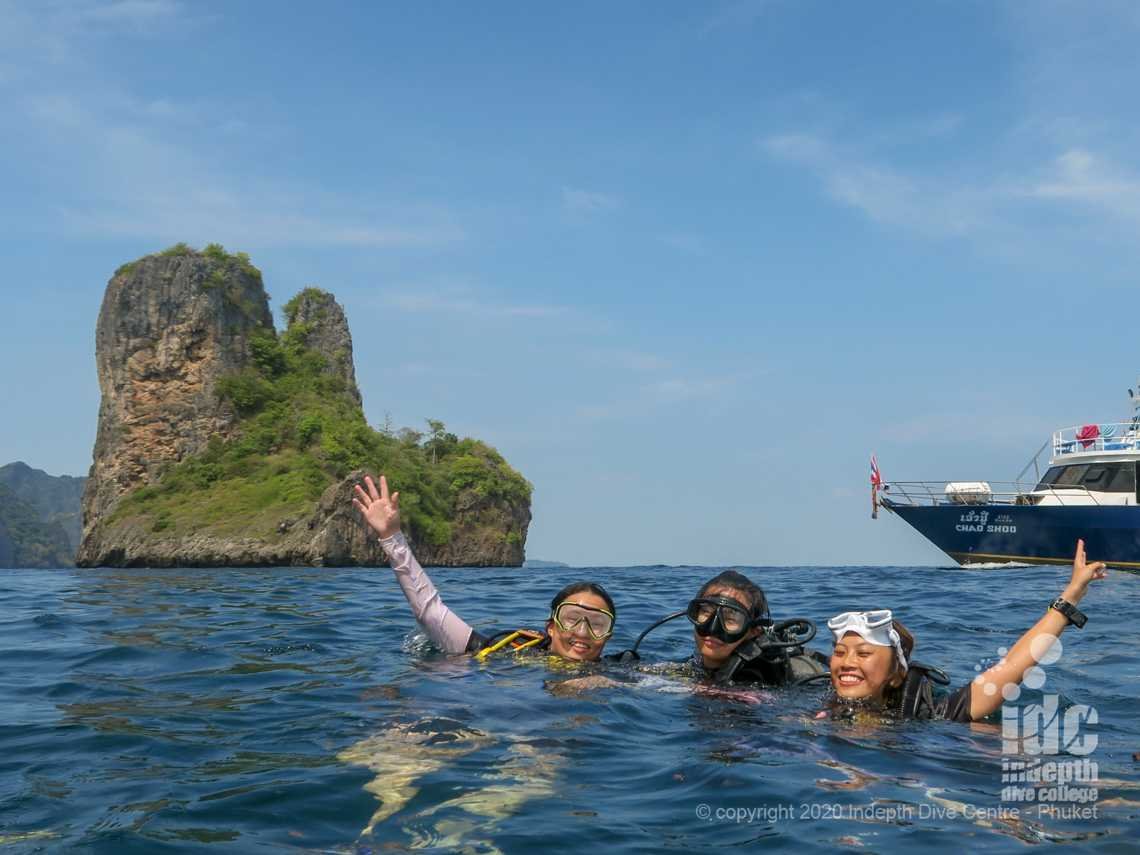
Phi Phi Islands: Ko Bida Nai
Ko Bida Nai is one the two southernmost islets, around 1.5km south of Koh Phi Phi Leh. Bida Nai is an amazing, but simple, limestone island rising from the Andaman Sea. This is an excellent dive for all levels of diver, both beginners and more experienced divers.
Divers usually enter the water on the Eastern side of the island and move steadily South around the rock. Bida Nai is home to a large variety of marine life and is especially renowned for its Leopard sharks and Stingrays lying on the sand. There are some large Hard Coral Gardens which provide an excellent habitat for a diverse range of Fish and invertebrates. Bida Nai is large enough that to stand a chance of seeing most of what it has to offer, because of this you would need to do at least 2 dives.
This is a dive site that has something to offer for every level of diver and is also a great setting in which to conduct PADI courses ...
The Phi Phi Islands and Ko Bida Nai
Ko Bida Nai has long been a favorite among Phuket Day trips and remains Phi Phi’s most popular dive sites.
We usually start this dive against the sheltered East face of the island, descending down the wall. Dropping down 5-10m it doesn’t take long before you come to the Hard Corals Gardens that make up the top part of the slope at 6-10m.
Divers can expect to find Lion fish hiding among the corals along with Bearded Scorpion Fish as they try to blend in with their surroundings. Although not famed for their beauty, Bearded Scorpion Fish do make great photo subjects. Not only are they actually quite photogenic, but they also stay stationary for long periods of time. As such they are great for new underwater photographers as they can take their time getting those itricky first shots.
Heading south we now follow the reef as it snakes its way down the side of the Ko Bida Nai. The abundance of Anemones and Anemone Fish is enough to delight any diver, especially beginner divers and photographers. As we reach the most southern point of the dive site it’s time to head out across the sand to a small pinnacle to the East.
What is there to see at Ko Bida Nai Pinnacle?
From here Ko Bida Nai pinnacle is not very far. Once you get there you will be in about 25m of water and you can expect to meet some Trumpet Fish on the way. In addition to the occasional Trigger Fish chasing others away from its nest. Take your time here as there is a lot to see, especially when the viz is 20-30m!
In the sand around Bida Nai Pinnacle it’s not unusual to come across half buried Stingrays buried in the sand. Moreover, Leopard Sharks are also known to be found here resting.
There is still plenty of the dive site left to see so head back over to the main part of the reef and continue following the wall round to the West. At 14m the wall gives way to a plateau at where a section of the cliff above collapsed thousands of years ago. This has created some interesting swim-throughs. Take your time exploring as it’s possible to find Bent Stick Pipefish in the sand. As well as Giant Trevally alongside Batfish and Puffer fish hanging out in the channels. You expect to see an abundance of reef fish as well as schools of resident Snapper that like the entrance area to the swimthrough.
Rebreather divers will again find this an excellent dive site. So, make the most of the awesome advantages rebreathers can offer. After all who wouldn’t want a 2-3 hour recreational no-decompression dive at Bida Nai?
The Phi Phi Day Trip is one of our most popular Dive Trip for divers who want to do their PADI Advanced Open Water Course. The large diversity of marine life, the amazing selection of corals and dive sites, makes this an exciting option for Advanced Open Water students.
How best end your dive
Finally, towards the end of the time it’s time to head back to shallower water. Rounding the North point of the island and coming back onto the East side, the wall starts to slope away. There are some stunning corals that make it is one of the defining features of the dive site. Additionally, Hawksbill Turtles can be found here sometimes, usually eating or sleeping.
Moreover keep your eyes open on your way back the wall as the top 10m is patrolled by Blacktip Reef Sharks ...












